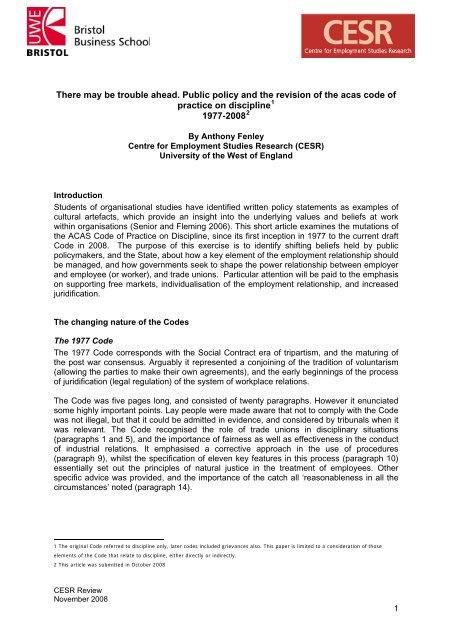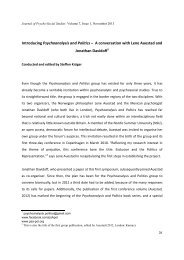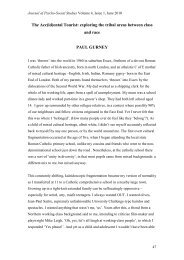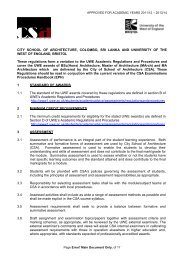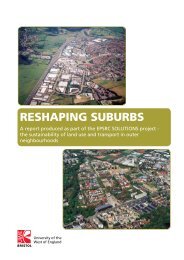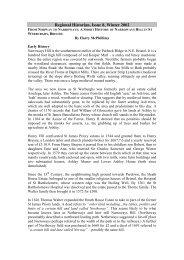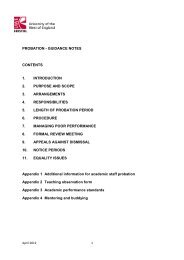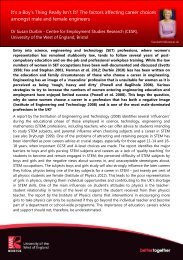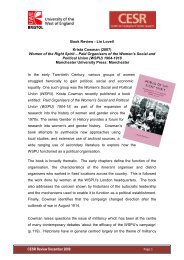There may be trouble ahead. Public policy and the revision of the ...
There may be trouble ahead. Public policy and the revision of the ...
There may be trouble ahead. Public policy and the revision of the ...
- No tags were found...
You also want an ePaper? Increase the reach of your titles
YUMPU automatically turns print PDFs into web optimized ePapers that Google loves.
<strong>There</strong> <strong>may</strong> <strong>be</strong> <strong>trouble</strong> <strong>ahead</strong>. <strong>Public</strong> <strong>policy</strong> <strong>and</strong> <strong>the</strong> <strong>revision</strong> <strong>of</strong> <strong>the</strong> acas code <strong>of</strong>practice on discipline 11977-2008 2By Anthony FenleyCentre for Employment Studies Research (CESR)University <strong>of</strong> <strong>the</strong> West <strong>of</strong> Engl<strong>and</strong>IntroductionStudents <strong>of</strong> organisational studies have identified written <strong>policy</strong> statements as examples <strong>of</strong>cultural artefacts, which provide an insight into <strong>the</strong> underlying values <strong>and</strong> <strong>be</strong>liefs at workwithin organisations (Senior <strong>and</strong> Fleming 2006). This short article examines <strong>the</strong> mutations <strong>of</strong><strong>the</strong> ACAS Code <strong>of</strong> Practice on Discipline, since its first inception in 1977 to <strong>the</strong> current draftCode in 2008. The purpose <strong>of</strong> this exercise is to identify shifting <strong>be</strong>liefs held by public<strong>policy</strong>makers, <strong>and</strong> <strong>the</strong> State, about how a key element <strong>of</strong> <strong>the</strong> employment relationship should<strong>be</strong> managed, <strong>and</strong> how governments seek to shape <strong>the</strong> power relationship <strong>be</strong>tween employer<strong>and</strong> employee (or worker), <strong>and</strong> trade unions. Particular attention will <strong>be</strong> paid to <strong>the</strong> emphasison supporting free markets, individualisation <strong>of</strong> <strong>the</strong> employment relationship, <strong>and</strong> increasedjuridification.The changing nature <strong>of</strong> <strong>the</strong> CodesThe 1977 CodeThe 1977 Code corresponds with <strong>the</strong> Social Contract era <strong>of</strong> tripartism, <strong>and</strong> <strong>the</strong> maturing <strong>of</strong><strong>the</strong> post war consensus. Arguably it represented a conjoining <strong>of</strong> <strong>the</strong> tradition <strong>of</strong> voluntarism(allowing <strong>the</strong> parties to make <strong>the</strong>ir own agreements), <strong>and</strong> <strong>the</strong> early <strong>be</strong>ginnings <strong>of</strong> <strong>the</strong> process<strong>of</strong> juridification (legal regulation) <strong>of</strong> <strong>the</strong> system <strong>of</strong> workplace relations.The Code was five pages long, <strong>and</strong> consisted <strong>of</strong> twenty paragraphs. However it enunciatedsome highly important points. Lay people were made aware that not to comply with <strong>the</strong> Codewas not illegal, but that it could <strong>be</strong> admitted in evidence, <strong>and</strong> considered by tribunals when itwas relevant. The Code recognised <strong>the</strong> role <strong>of</strong> trade unions in disciplinary situations(paragraphs 1 <strong>and</strong> 5), <strong>and</strong> <strong>the</strong> importance <strong>of</strong> fairness as well as effectiveness in <strong>the</strong> conduct<strong>of</strong> industrial relations. It emphasised a corrective approach in <strong>the</strong> use <strong>of</strong> procedures(paragraph 9), whilst <strong>the</strong> specification <strong>of</strong> eleven key features in this process (paragraph 10)essentially set out <strong>the</strong> principles <strong>of</strong> natural justice in <strong>the</strong> treatment <strong>of</strong> employees. O<strong>the</strong>rspecific advice was provided, <strong>and</strong> <strong>the</strong> importance <strong>of</strong> <strong>the</strong> catch all ‘reasonableness in all <strong>the</strong>circumstances’ noted (paragraph 14).1 The original Code referred to discipline only, later codes included grievances also. This paper is limited to a consideration <strong>of</strong> thoseelements <strong>of</strong> <strong>the</strong> Code that relate to discipline, ei<strong>the</strong>r directly or indirectly.2 This article was submitted in Octo<strong>be</strong>r 2008CESR ReviewNovem<strong>be</strong>r 20081
The Code was an example <strong>of</strong> a streng<strong>the</strong>ned voluntarism that provided a normativeframework for parties to pursue <strong>be</strong>st practice, but in addition it furnished a potentialunderpinning for those employees who were not organised, <strong>and</strong> for those employers withoutknowledge <strong>of</strong> disciplinary policies <strong>and</strong> processes. The law that under pinned <strong>the</strong> Codeformed <strong>the</strong> basis for <strong>the</strong> increased formalisation <strong>of</strong> workplace procedures in this area (Cully1999, Lewis <strong>and</strong> Simpson 1981). However successive Conservative governments felt thiswas sufficiently interventionist, so that <strong>the</strong> Code was augmented instead by an ACASadvisory book <strong>of</strong> 50 pages which was, ‘purely advisory <strong>and</strong> did not have <strong>the</strong> status <strong>of</strong> a Code<strong>of</strong> Practice. (ACAS 187:4)The 2000 CodeThe advent <strong>of</strong> a New Labour Government led to <strong>the</strong> first set <strong>of</strong> substantive changes to <strong>the</strong>Code in 2000, this also incorporated advice on grievances, but took account <strong>of</strong> <strong>the</strong>individual’s right to <strong>be</strong> accompanied at both disciplinary <strong>and</strong> grievance interviews.The 2000 Code was more extensive than its predecessor, containing an initial thirty-threeparagraphs on discipline, <strong>and</strong> a fur<strong>the</strong>r sixteen on <strong>the</strong> right to <strong>be</strong> accompanied.The 2000 Code appeared to <strong>be</strong> a streng<strong>the</strong>ning <strong>of</strong> <strong>the</strong> position <strong>of</strong> employees reflected in <strong>the</strong>statutory right to <strong>be</strong> accompanied at disciplinaries <strong>and</strong> grievances. <strong>There</strong> is specificreference to <strong>the</strong> rights <strong>of</strong> natural justice, <strong>and</strong> fourteen essential features <strong>of</strong> <strong>the</strong> disciplinaryprocedure identified in support <strong>of</strong> this approach. However it can <strong>be</strong> contested that this Codestrongly suggested a move towards both <strong>the</strong> individualisation <strong>and</strong> juridification <strong>of</strong> <strong>the</strong>employment relationship. The introductory paragraph contains no specific reference to tradeunions per se (paragraph 1), whilst <strong>the</strong> right to <strong>be</strong> accompanied makes clear that is notnecessarily via <strong>the</strong> trade union route (paragraphs 50-66). The terminology encapsulated in<strong>the</strong> right to <strong>be</strong> accompanied, as opposed to <strong>the</strong> right to <strong>be</strong> represented is indicative <strong>of</strong> apotential dilution <strong>of</strong> a workplace role for unions, seen in <strong>the</strong> context <strong>of</strong> detailed prescriptions,enveloped within statute law, on conduct within <strong>the</strong> meetings (paragraphs 63 <strong>and</strong> 64). Thesummarisation <strong>of</strong> statutory rights in bold throughout <strong>the</strong> text <strong>of</strong> <strong>the</strong> Code provided a fur<strong>the</strong>rpointer to <strong>the</strong> shift from streng<strong>the</strong>ned voluntarism towards increased juridification.The 2004 CodeIn 2004 <strong>the</strong> third embodiment <strong>of</strong> <strong>the</strong> Code was made ostensibly to take account <strong>of</strong> legalresponsibilities in accordance with <strong>the</strong> Statutory Disputes procedures, <strong>and</strong> a desire to keep<strong>the</strong> num<strong>be</strong>r <strong>of</strong> employment tribunal cases down.The 2004 Code consists <strong>of</strong> 116 paragraphs. It is 42 pages long, including 10 pages <strong>of</strong>appendices. It represents a significant shift from <strong>the</strong> 1977 version. Paragraph 6 refers to <strong>the</strong>statutory minimum Code <strong>and</strong> continues to emphasise <strong>the</strong> importance <strong>of</strong> <strong>the</strong> catch all ‘actingreasonably in all <strong>the</strong> circumstances’. However paragraphs 26-32 enters into considerabledetail about <strong>the</strong> content <strong>of</strong> <strong>the</strong> statutory procedures, detailed advise on exemptions,situations where it relates potential findings <strong>of</strong> automatically unfair dismissal, <strong>and</strong> <strong>the</strong> impacton compensation levels. It goes into detail about circumstances <strong>be</strong>yond <strong>the</strong> control <strong>of</strong> parties,non-attendance by employees, <strong>and</strong> dealing with grievances raised during disciplinaryproceedings. <strong>There</strong> are twenty paragraphs dealing with <strong>the</strong> right to accompaniment,including those on grievances, that set out what is <strong>and</strong> is not contractual, <strong>and</strong> detailappropriate protocols at <strong>the</strong> meetings.CESR ReviewNovem<strong>be</strong>r 20082
At <strong>the</strong> heart <strong>of</strong> <strong>the</strong> 2004 Code, which arguably palls under <strong>the</strong> weight <strong>of</strong> legislation, is aparadox that arguably encapsulates <strong>the</strong> contradictions at <strong>the</strong> heart <strong>of</strong> successive NewLabour administrations. On <strong>the</strong> one h<strong>and</strong> <strong>the</strong>re is increased regulation <strong>and</strong> <strong>the</strong> apparent<strong>be</strong>stowing <strong>of</strong> rights on employees <strong>and</strong> workers. On <strong>the</strong> o<strong>the</strong>r h<strong>and</strong> <strong>the</strong>re is <strong>the</strong> desire tomicro manage <strong>the</strong> dynamics <strong>and</strong> mechanics <strong>of</strong> <strong>the</strong> disciplinary process through <strong>the</strong> highlydetailed specification <strong>of</strong> how meetings should <strong>be</strong> conducted (paragraphs 96-116), <strong>and</strong> <strong>the</strong>rapidly increasing juridification, alluded to earlier, that inevitably moves <strong>the</strong> initiative with<strong>the</strong>se matters away from <strong>the</strong> workplace <strong>and</strong> into <strong>the</strong> purview <strong>of</strong> <strong>the</strong> legal pr<strong>of</strong>ession <strong>and</strong> <strong>the</strong>courts.The 2008 Draft CodeThe failure <strong>of</strong> <strong>the</strong> Statutory Disputes procedures to reduce <strong>the</strong> num<strong>be</strong>r <strong>of</strong> tribunal cases, <strong>and</strong>subsequent criticisms <strong>of</strong> <strong>the</strong> prevailing situation in <strong>the</strong> Gibbons Report (2007), led to a newdraft Code <strong>be</strong>en tabled in May 2008, designed to overcome <strong>the</strong> problems identified byGibbons. This is expected to <strong>be</strong>come operative in April 2009.The draft Code was a consequence <strong>of</strong> recommendations in <strong>the</strong> Gibbons Report, <strong>and</strong> <strong>the</strong>proposed removal <strong>of</strong> statutory dismissal <strong>and</strong> discipline procedures (Gibbons 2007, ACAS2008), <strong>the</strong> former having called for ‘clear, simple, non-prescriptive guidelines’ (Gibbons2007:30). The five pages <strong>of</strong> <strong>the</strong> draft Code deal with discipline issues in thirty paragraphs,adopting arguably a highly minimalist approach. In <strong>the</strong> foreword no reference is made totrade unions, but later paragraphs do acknowledge <strong>the</strong> trade union role (paragraph 3). Theemphasis is on informality <strong>and</strong> sees recourse to employment tribunals as a last resort.Paragraph six which refers to <strong>the</strong> formal processes <strong>of</strong> discipline contains only six sub points,considerably fewer than those in previous Codes.Amongst <strong>the</strong> 170 responses to <strong>the</strong> draft are those from <strong>the</strong> Law Society (2008) <strong>and</strong> fromThompsons (2008), <strong>the</strong> main solicitors for trade unions. Concern is expressed that <strong>the</strong> Codecontains conflicting principles since it will <strong>be</strong> taken into account to establish liability, but inaddition where ei<strong>the</strong>r party has failed to comply with <strong>the</strong> Codes’ provisions, resultingcompensation <strong>may</strong> <strong>be</strong> adjusted by up to 25 per cent. The Law Society <strong>be</strong>lieves <strong>the</strong> bareessentials approach in <strong>the</strong> Code is <strong>the</strong> exact opposite <strong>of</strong> <strong>the</strong> prescriptive, guidance-basedapproach that employers <strong>and</strong> employees need. They note <strong>the</strong> failure to emphasise thatdiscipline should <strong>be</strong> used when o<strong>the</strong>r methods have failed <strong>and</strong> <strong>the</strong> omission <strong>of</strong> references to<strong>the</strong> principles <strong>of</strong> Natural Justice. Thompsons (2008) also see <strong>the</strong> draft Code as taking alowest common denominator approach, <strong>and</strong> a need for clearer guidance on how employersshould conduct <strong>the</strong>ir procedures, <strong>and</strong> <strong>the</strong> need to set st<strong>and</strong>ards <strong>of</strong> fairness.Thompsons also note <strong>the</strong> absence <strong>of</strong> a corrective approach <strong>and</strong> a dilution <strong>of</strong> guidance inrespect <strong>of</strong> <strong>the</strong> formal/informal distinction, clarity <strong>and</strong> availability <strong>of</strong> rules <strong>and</strong> procedures toemployees, <strong>and</strong> <strong>the</strong> absence <strong>of</strong> guidance on conducting investigations.They also express concern with regard to evidence made available to employees <strong>and</strong> <strong>the</strong>irexplicit right to test <strong>the</strong> evidence, failures over advising about <strong>the</strong> right to appeals, vaguenessover <strong>the</strong> duration <strong>of</strong> warnings <strong>and</strong> <strong>the</strong> need for greater information in warnings (Thompsons2008)CESR ReviewNovem<strong>be</strong>r 20083
The role <strong>of</strong> <strong>the</strong> StateWhilst highlighting <strong>the</strong> potential <strong>and</strong> actual repression by <strong>the</strong> State <strong>of</strong> employees through <strong>the</strong>prism <strong>of</strong> historical perspective, Kelly identified <strong>the</strong> ‘contradiction <strong>be</strong>tween <strong>the</strong> logic <strong>of</strong>accumulation which periodically requires a cut back in workers terms <strong>and</strong> conditions <strong>of</strong>employment, <strong>and</strong> <strong>the</strong> logic <strong>of</strong> legitimation, which requires that <strong>the</strong> victims <strong>of</strong> capitalistaccumulation are protected from its costs if <strong>the</strong> system is to survive with <strong>the</strong>ir support’ (Kelly1998:56). Writing much earlier Barratt Brown referred to not only <strong>the</strong> repressive nature <strong>of</strong> <strong>the</strong>State, citing Marx’s dictum that, ‘<strong>the</strong> executive <strong>of</strong> <strong>the</strong> modern state is but a committee formanaging <strong>the</strong> affairs <strong>of</strong> <strong>the</strong> whole bourgeoisie.’ (Barratt Brown 1971:186), but also itsideological role, referring to Milib<strong>and</strong> <strong>and</strong> Poulantzas, in legitimising class interests throughState power.However Barratt Brown went <strong>be</strong>yond this. He rejected <strong>the</strong> idea <strong>of</strong> ‘a neutral state subject topluralist pressures’ (ibid: 185), arguing instead that <strong>the</strong> State had, ‘a conformative role, whichcontain, incorporate <strong>and</strong> moderate <strong>the</strong> conflicts inside capitalist society.’ (ibid: 186). It wasimportant, <strong>the</strong>refore to recognise that <strong>the</strong> State was not a monolith, but a set <strong>of</strong> institutionsdesigned to incorporate conflict, which was independent from <strong>and</strong> superior to all socialclasses ra<strong>the</strong>r than <strong>be</strong>en dominated by one.Interestingly Gibbons indicates this conformative role, in referring to <strong>the</strong> impact <strong>of</strong> hisrecommendations, whilst:“…implying a net increase in costs to <strong>the</strong> State, should include<strong>be</strong>nefits <strong>and</strong> burden reductions to employers <strong>and</strong> employeeswhich far outweigh <strong>the</strong> costs to <strong>the</strong> State.” (Gibbons Better2007:7).In relating this brief discussion <strong>of</strong> <strong>the</strong> role <strong>of</strong> <strong>the</strong> State to trends in public <strong>policy</strong>, a valuablelink is provided by Davies <strong>and</strong> Freedl<strong>and</strong>’s consideration <strong>of</strong> <strong>the</strong> aims <strong>of</strong> New Labour’semployment law initiatives, <strong>and</strong> <strong>the</strong> shift away from correcting <strong>the</strong> ‘inequality <strong>of</strong> bargainingpower <strong>be</strong>tween management <strong>and</strong> workers’ (ibid 2007:8). They note <strong>the</strong> dual but conflictinggoals <strong>of</strong> promoting first a free market economy underscored by labour flexibility, <strong>and</strong>secondly providing worker protection <strong>and</strong> social inclusivity. In describing Blairism as amodified form <strong>of</strong> neo-li<strong>be</strong>ralism/Thatcherism (ibid: 240), <strong>the</strong>y also note that New Labour hada, ‘more nuanced vision <strong>of</strong> <strong>the</strong> labour market’ (ibid: 246). They postulate a continuum whereif X is highly welfarist promoting worker protection, <strong>and</strong> Y is strongly neo li<strong>be</strong>ralism, ‘<strong>the</strong>movement from extreme X to extreme Y <strong>may</strong> turn out to necessitate a higher level <strong>of</strong>regulation than <strong>be</strong>fore.’ (ibid: 242). Renton (2007) raises <strong>the</strong> possibility that <strong>the</strong> complexity<strong>and</strong> difficulties <strong>of</strong> <strong>the</strong> statutory procedures might have <strong>be</strong>en a deli<strong>be</strong>rate State strategy todiscourage workers from exercising <strong>the</strong>ir rights, <strong>and</strong> promote a fur<strong>the</strong>r shift to involvinglawyers prematurely <strong>and</strong> unhappily. But given <strong>the</strong> consequences <strong>of</strong> this, <strong>and</strong> <strong>the</strong> <strong>be</strong>moaning<strong>of</strong> its impact on business interests, Renton rightly descri<strong>be</strong>s this as proving <strong>the</strong> iron law <strong>of</strong>unintended consequences.CESR ReviewNovem<strong>be</strong>r 20084
ConclusionsThis paper contends that <strong>the</strong> ACAS Code can <strong>be</strong> viewed as a cultural artefact providinginsights into <strong>the</strong> underlying <strong>be</strong>liefs <strong>and</strong> values <strong>of</strong> <strong>the</strong> State, <strong>and</strong> especially during <strong>the</strong> period<strong>of</strong> <strong>the</strong> New Labour regimes (1997-2008). The original Code 1977 can <strong>be</strong> seen as part <strong>of</strong> amore regulated voluntarism providing a normative framework for <strong>the</strong> parties, falling withinBarratt Brown’s definition <strong>of</strong> a conformative role for <strong>the</strong> State. Whilst this role is notcompletely eroded in <strong>the</strong> Codes <strong>of</strong> 2000 <strong>and</strong> 2004, <strong>and</strong> important normative elements areretained we see a shift towards an approach that is over regulatory, designed to supportmarket freedoms, individualisation <strong>and</strong> juridification. The contradiction at <strong>the</strong> heart <strong>of</strong> NewLabour in seeking to meet <strong>the</strong> goal <strong>of</strong> employee protection whilst sustaining business within afree market economy led inevitably to <strong>the</strong> worst <strong>of</strong> two worlds. Gibbons has <strong>be</strong>en critical <strong>of</strong> itsimpact not only on employers, but also on employees <strong>and</strong> trade unions. However <strong>the</strong> newdraft Code in response to Gibbons is excessively minimalist. In seeking a bare bones, nonprescriptiveapproach, it risks not only diluting employee rights based on justice establishedby <strong>the</strong> original Code, but also distorting normative frameworks that serve <strong>the</strong> parties well involuntarily resolving workplace disciplinary issues.The increased statutory importance <strong>of</strong> <strong>the</strong> Code with regard to <strong>the</strong> awarding <strong>of</strong>compensation, at <strong>the</strong> same time as <strong>the</strong> substantive <strong>and</strong> authoritative guidance <strong>of</strong> <strong>the</strong> Code isdiluted appears to <strong>be</strong> highly contradictory or cynical to a fault.<strong>There</strong> <strong>may</strong> <strong>be</strong> <strong>trouble</strong> <strong>ahead</strong>.CESR ReviewNovem<strong>be</strong>r 20085
ReferencesACAS (1977) Disciplinary practice <strong>and</strong> procedures in employment.ACAS (1987) Discipline at Work. The ACAS advisory h<strong>and</strong>book.ACAS (2000) Code <strong>of</strong> Practice on disciplinary <strong>and</strong> grievance procedures.ACAS (2004) Code <strong>of</strong> Practice on Disciplinary <strong>and</strong> grievance proceduresACAS (2004) Discipline <strong>and</strong> grievances at work h<strong>and</strong>bookACAS (2008) Draft Code <strong>of</strong> Practice on discipline <strong>and</strong> grievance. Draft for Consultation.Barratt Brown, M. (1971) ‘The Welfare State in Britain’ in Socialist Register, 1971.Dti (2007) Success at Work. Resolving Disputes in <strong>the</strong> workplace. A consultation. London.Cully, M., Woodl<strong>and</strong>, S., O’Reilly, A., <strong>and</strong> Dix, G. (1999), Britain at Work, London, Routledge.Davies, P <strong>and</strong> Freedl<strong>and</strong>, M. (2007) Towards a Flexible Labour Market: Labour Legislation<strong>and</strong> Regulation since <strong>the</strong> 1990s, Oxford, Oxford University Press.Gibbons, M. (2007) Better Dispute Resolution. A review <strong>of</strong> employment dispute resolution inGreat Britain. London, Dti.Kelly, J. (1998), Rethinking Industrial Relations, London, Routledge.Lewis, R. <strong>and</strong> Simpson, B. (1981) Striking a Balance? Employment Law after <strong>the</strong> 1980 Act,Oxford, Martin Robinson.Senior, B. <strong>and</strong> Fleming, J.3 rd Edition (2006), Organisational Change, Essex, PearsonEducation.Law Society (2008), Draft ACAS Code <strong>of</strong> Practice on discipline <strong>and</strong> grievance. Response to<strong>the</strong> consultation.Renton, D. ‘”Deliver us from Employment Tribunal Hell” Employment Law, Industrial relations<strong>and</strong> <strong>the</strong> Employment Bill.’ Unpublished paper, University <strong>of</strong> Hertfordshire, 2007Thompson Solicitors (2008), Discipline <strong>and</strong> grievances at work: Draft ACAS guideconsultation. Response by Thompsons Solicitors.CESR ReviewNovem<strong>be</strong>r 20086


